Marko Djurasevic
Digging Deeper: Operator Analysis for Optimizing Nonlinearity of Boolean Functions
Feb 12, 2023Abstract:Boolean functions are mathematical objects with numerous applications in domains like coding theory, cryptography, and telecommunications. Finding Boolean functions with specific properties is a complex combinatorial optimization problem where the search space grows super-exponentially with the number of input variables. One common property of interest is the nonlinearity of Boolean functions. Constructing highly nonlinear Boolean functions is difficult as it is not always known what nonlinearity values can be reached in practice. In this paper, we investigate the effects of the genetic operators for bit-string encoding in optimizing nonlinearity. While several mutation and crossover operators have commonly been used, the link between the genotype they operate on and the resulting phenotype changes is mostly obscure. By observing the range of possible changes an operator can provide, as well as relative probabilities of specific transitions in the objective space, one can use this information to design a more effective combination of genetic operators. The analysis reveals interesting insights into operator effectiveness and indicates how algorithm design may improve convergence compared to an operator-agnostic genetic algorithm.
On the Evolution of Boomerang Uniformity in Cryptographic S-boxes
Dec 09, 2022Abstract:S-boxes are an important primitive that help cryptographic algorithms to be resilient against various attacks. The resilience against specific attacks can be connected with a certain property of an S-box, and the better the property value, the more secure the algorithm. One example of such a property is called boomerang uniformity, which helps to be resilient against boomerang attacks. How to construct S-boxes with good boomerang uniformity is not always clear. There are algebraic techniques that can result in good boomerang uniformity, but the results are still rare. In this work, we explore the evolution of S-boxes with good values of boomerang uniformity. We consider three different encodings and five S-box sizes. For sizes $4\times 4$ and $5\times 5$, we manage to obtain optimal solutions. For $6\times 6$, we obtain optimal boomerang uniformity for the non-APN function. For larger sizes, the results indicate the problem to be very difficult (even more difficult than evolving differential uniformity, which can be considered a well-researched problem).
Evolving Constructions for Balanced, Highly Nonlinear Boolean Functions
Feb 17, 2022
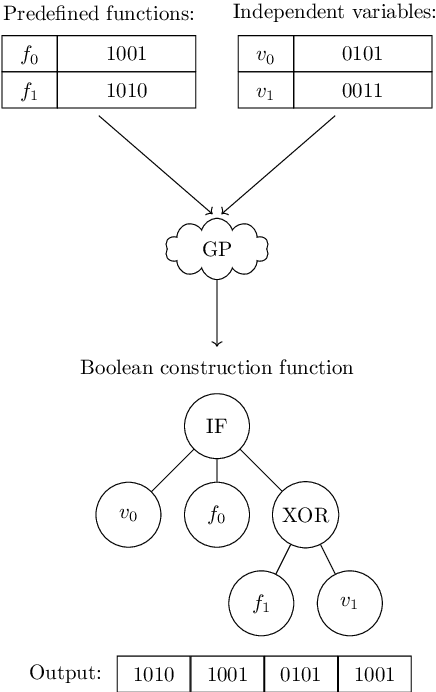
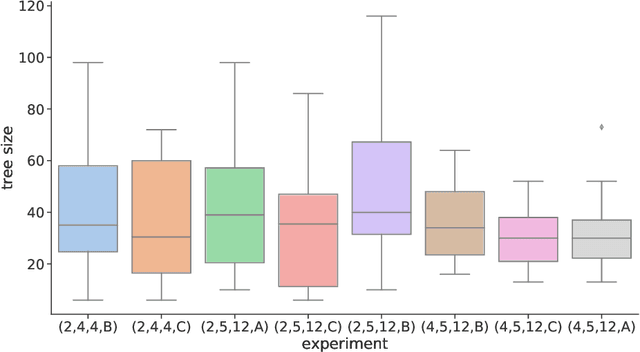

Abstract:Finding balanced, highly nonlinear Boolean functions is a difficult problem where it is not known what nonlinearity values are possible to be reached in general. At the same time, evolutionary computation is successfully used to evolve specific Boolean function instances, but the approach cannot easily scale for larger Boolean function sizes. Indeed, while evolving smaller Boolean functions is almost trivial, larger sizes become increasingly difficult, and evolutionary algorithms perform suboptimally. In this work, we ask whether genetic programming (GP) can evolve constructions resulting in balanced Boolean functions with high nonlinearity. This question is especially interesting as there are only a few known such constructions. Our results show that GP can find constructions that generalize well, i.e., result in the required functions for multiple tested sizes. Further, we show that GP evolves many equivalent constructions under different syntactic representations. Interestingly, the simplest solution found by GP is a particular case of the well-known indirect sum construction.
Evolutionary Construction of Perfectly Balanced Boolean Functions
Feb 16, 2022
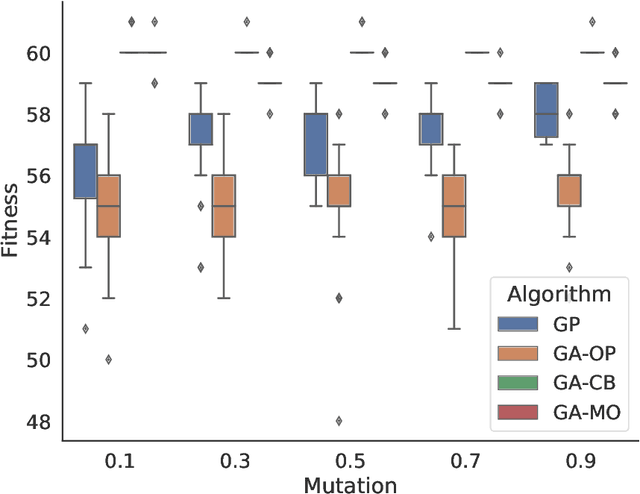

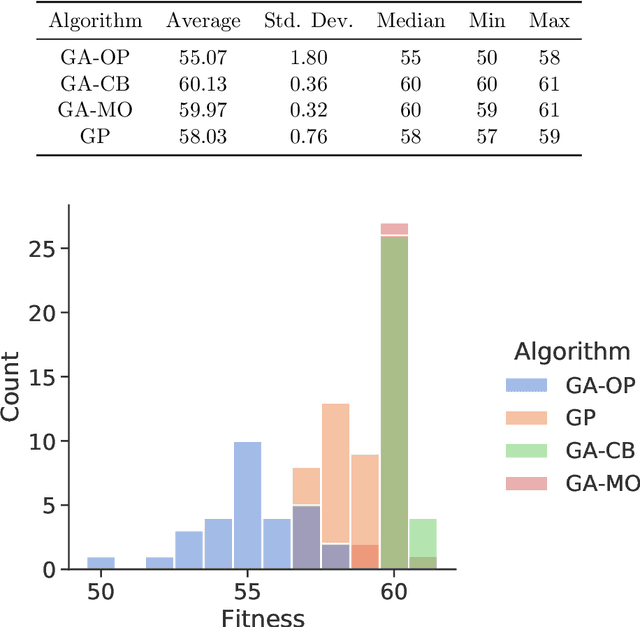
Abstract:Finding Boolean functions suitable for cryptographic primitives is a complex combinatorial optimization problem, since they must satisfy several properties to resist cryptanalytic attacks, and the space is very large, which grows super exponentially with the number of input variables. Recent research has focused on the study of Boolean functions that satisfy properties on restricted sets of inputs due to their importance in the development of the FLIP stream cipher. In this paper, we consider one such property, perfect balancedness, and investigate the use of Genetic Programming (GP) and Genetic Algorithms (GA) to construct Boolean functions that satisfy this property along with a good nonlinearity profile. We formulate the related optimization problem and define two encodings for the candidate solutions, namely the truth table and the weightwise balanced representations. Somewhat surprisingly, the results show that GA with the weightwise balanced representation outperforms GP with the classical truth table phenotype in finding highly nonlinear WPB functions. This finding is in stark contrast to previous findings on the evolution of globally balanced Boolean functions, where GP always performs best.
Modeling Strong Physically Unclonable Functions with Metaheuristics
Feb 16, 2022
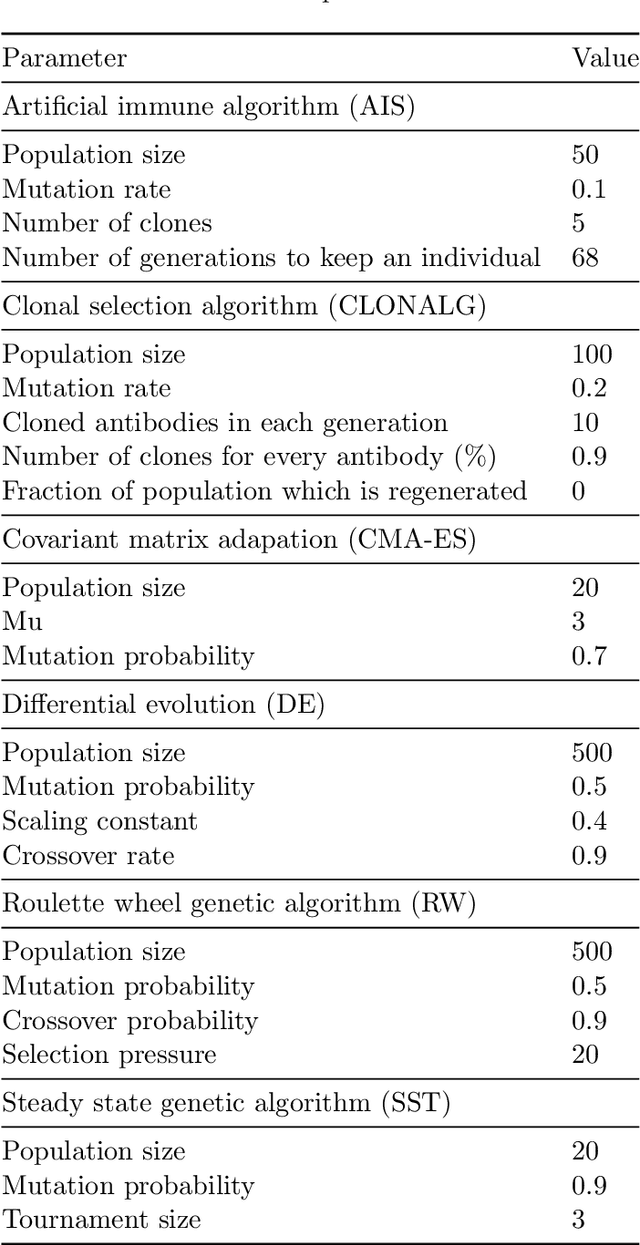
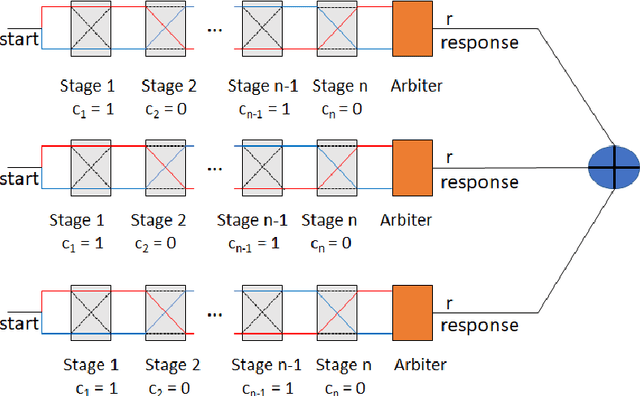
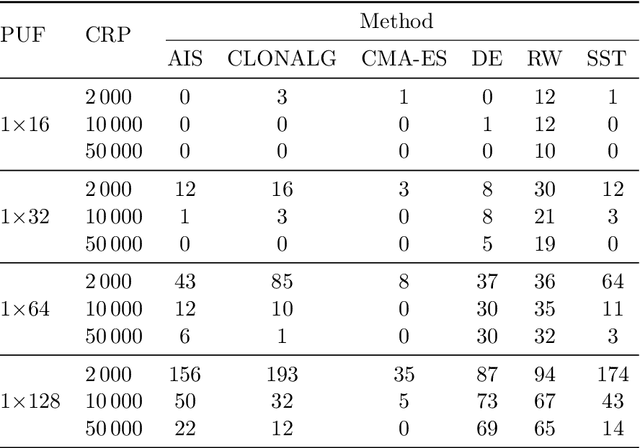
Abstract:Evolutionary algorithms have been successfully applied to attacking Physically Unclonable Functions (PUFs). CMA-ES is recognized as the most powerful option for a type of attack called the reliability attack. While there is no reason to doubt the performance of CMA-ES, the lack of comparison with different metaheuristics and results for the challenge-response pair-based attack leaves open questions if there are better-suited metaheuristics for the problem. In this paper, we take a step back and systematically evaluate several metaheuristics for the challenge-response pair-based attack on strong PUFs. Our results confirm that CMA-ES has the best performance, but we also note several other algorithms with similar performance while having smaller computational costs. More precisely, if we provide a sufficient number of challenge-response pairs to train the algorithm, various configurations show good results. Consequently, we conclude that EAs represent a strong option for challenge-response pair-based attacks on PUFs.
On the Difficulty of Evolving Permutation Codes
Nov 25, 2021
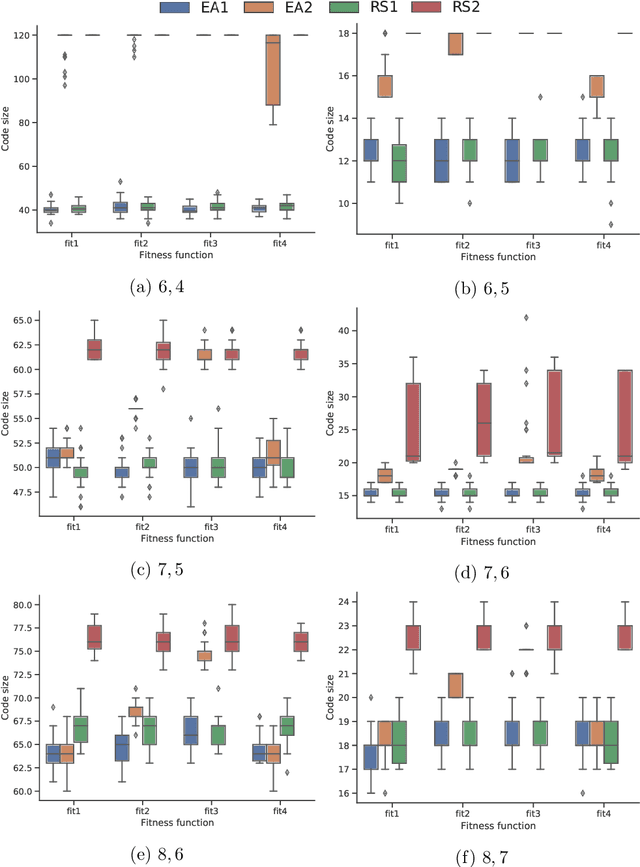
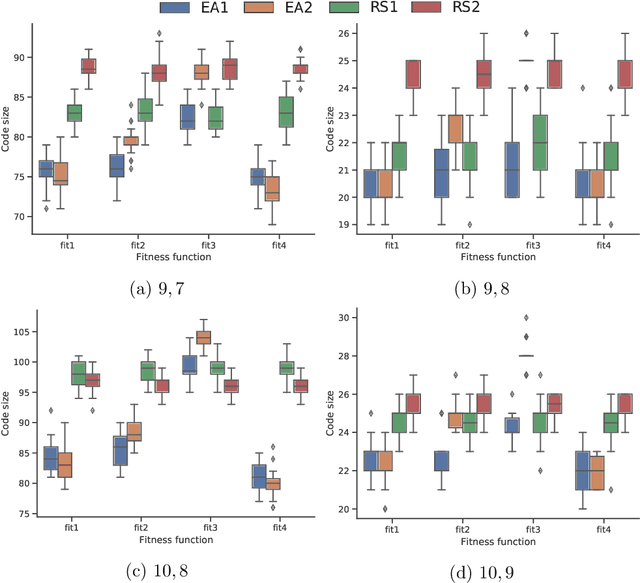
Abstract:Combinatorial designs provide an interesting source of optimization problems. Among them, permutation codes are particularly interesting given their applications in powerline communications, flash memories, and block ciphers. This paper addresses the design of permutation codes by evolutionary algorithms (EA) by developing an iterative approach. Starting from a single random permutation, new permutations satisfying the minimum distance constraint are incrementally added to the code by using a permutation-based EA. We investigate our approach against four different fitness functions targeting the minimum distance requirement at different levels of detail and with two different policies concerning code expansion and pruning. We compare the results achieved by our EA approach to those of a simple random search, remarking that neither method scales well with the problem size.
On the Genotype Compression and Expansion for Evolutionary Algorithms in the Continuous Domain
May 24, 2021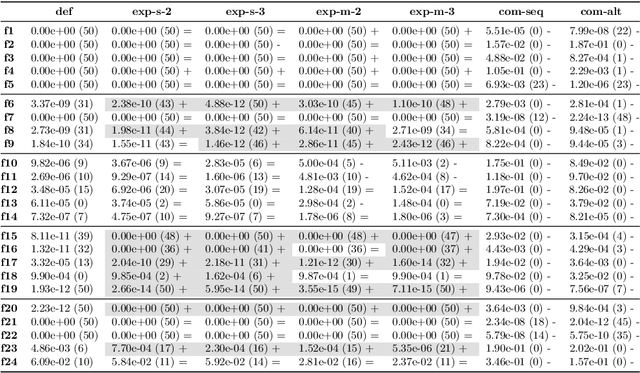
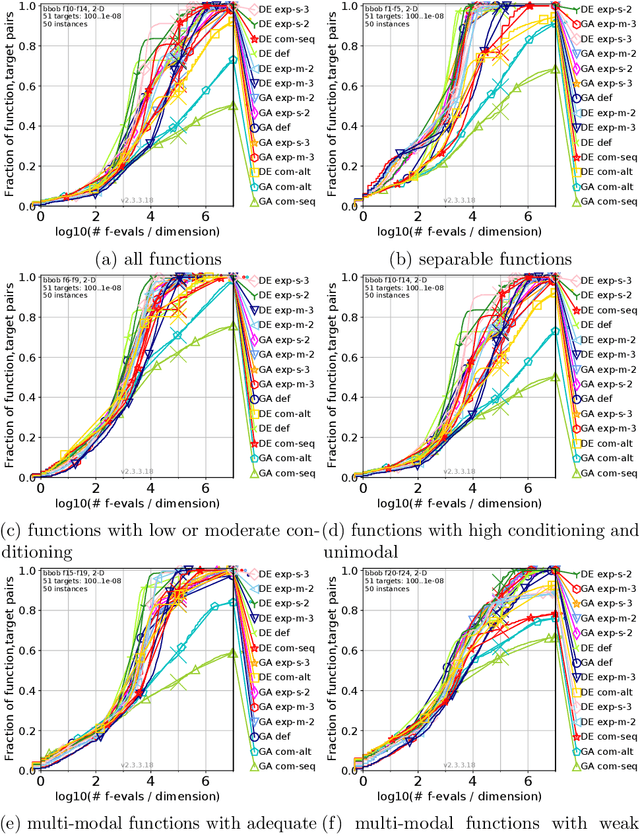
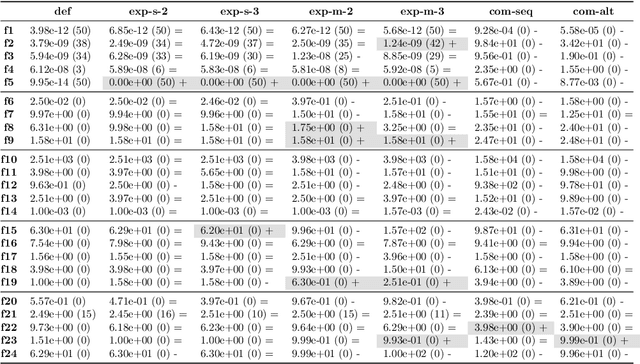
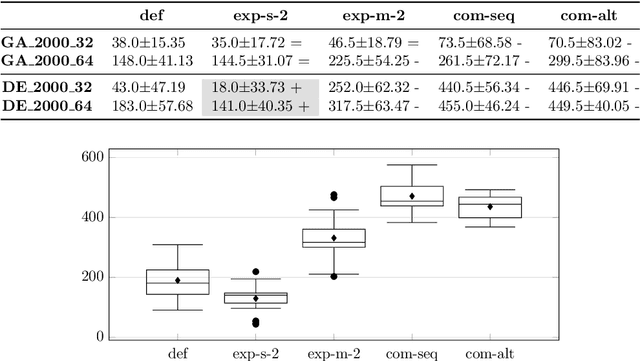
Abstract:This paper investigates the influence of genotype size on evolutionary algorithms' performance. We consider genotype compression (where genotype is smaller than phenotype) and expansion (genotype is larger than phenotype) and define different strategies to reconstruct the original variables of the phenotype from both the compressed and expanded genotypes. We test our approach with several evolutionary algorithms over three sets of optimization problems: COCO benchmark functions, modeling of Physical Unclonable Functions, and neural network weight optimization. Our results show that genotype expansion works significantly better than compression, and in many scenarios, outperforms the original genotype encoding. This could be attributed to the change in the genotype-phenotype mapping introduced with the expansion methods: this modification beneficially transforms the domain landscape and alleviates the search space traversal.
 Add to Chrome
Add to Chrome Add to Firefox
Add to Firefox Add to Edge
Add to Edge